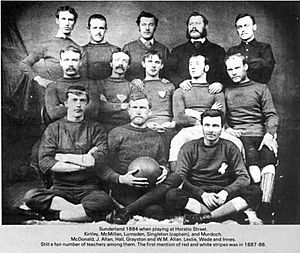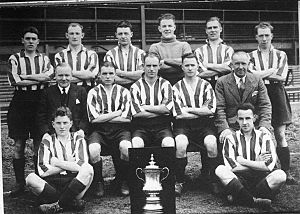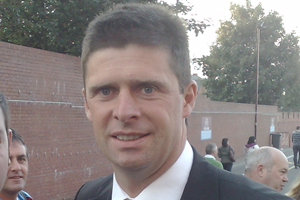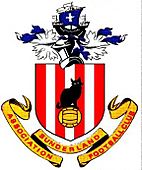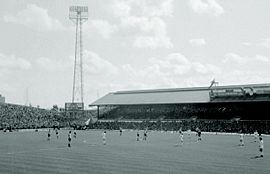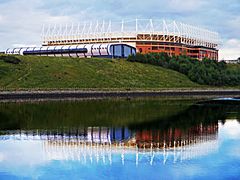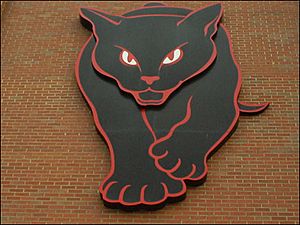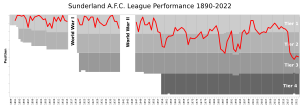Sunderland A.F.C. facts for kids
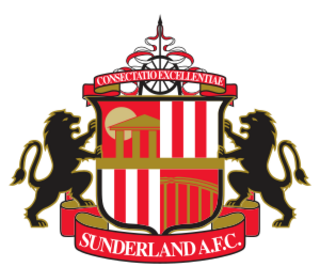 |
||
| Full name | Sunderland Association Football Club | |
|---|---|---|
| Nickname(s) |
|
|
| Short name | SAFC | |
| Founded | 1879 (as Sunderland and District Teachers) |
|
| Ground | Stadium of Light | |
| Capacity | 49,000 | |
| Owner | Kyril Louis-Dreyfus (64%) Juan Sartori (36%) |
|
| Chairman | Kyril Louis-Dreyfus | |
| Head coach | Régis Le Bris | |
| League | League One | |
| 2018–19 | League One, 5th of 24 | |
|
|
||
Sunderland Association Football Club is a professional football team from Sunderland, England. They play in the Premier League, which is the top football league in England.
The club started in 1879. Sunderland has won the top league title six times, and the FA Cup twice, in 1937 and 1973. They also won the FA Charity Shield in 1936.
Sunderland is known as "The Black Cats." They play their home games at the Stadium of Light, which can hold 49,000 fans. They moved there in 1997 from their old stadium, Roker Park. Sunderland has a big rivalry with Newcastle United, and their matches are called the Tyne–Wear derby. The team wears red and white striped shirts with black shorts.
Contents
Club History and Achievements
The Early Years: "Team of All Talents" (1879–1908)
Sunderland A.F.C. was founded by a schoolmaster named James Allan. It was first called Sunderland and District Teachers A.F.C. in 1879, but became Sunderland A.F.C. in 1880.
Sunderland joined The Football League in the 1890–91 season. They quickly became very strong. After a big 7–2 win against Aston Villa, the league's founder called them the "Team of All Talents." Sunderland won their first league championship in the 1891–92 season, just one year after joining the league. They won again the next season, helped by their Scottish striker John Campbell, who scored over 30 goals twice. They were also the first team to score 100 goals in a season!
Sunderland won the league title for a third time in the 1894–95 season. After this, they played against Scottish champions Heart of Midlothian in a game called the "World Championship" match, and won. Their goalkeeper, Ned Doig, set a record by not letting in goals in 87 of his 290 top games. From 1886 to 1898, Sunderland played at Newcastle Road. In 1898, they moved to Roker Park, which would be their home for nearly 100 years.
More League Titles and FA Cup Glory (1908–1945)
On 5 December 1908, Sunderland had their biggest league win ever, beating rivals Newcastle United 9–1. The club won the league again in 1913, but lost their first FA Cup final to Aston Villa.
Sunderland won their sixth league championship in the 1935–36 season. They scored 109 goals that season, with Raich Carter and Bobby Gurney each scoring 31. They then won the Charity Shield against Arsenal.
Sadly, during this winning season, their young goalkeeper, Jimmy Thorpe, passed away after being kicked during a game. This led to a new rule to protect goalkeepers. The team then won the FA Cup the next season, beating Preston North End 3–1 at Wembley Stadium.
Post-War Era and Cup Finals (1945–1995)
After World War II, Sunderland spent a lot of money on new players, earning them the nickname the "Bank of England club." They finished third in the top division in 1950, their best finish since 1936.
However, in 1957, the club faced financial trouble and was fined. The next year, Sunderland was relegated from the top division for the first time in 68 years. They returned to the top league in 1964 but were relegated again by the end of the decade.
Sunderland won their last major trophy in 1973, beating Don Revie's strong Leeds United 1–0 in the FA Cup Final. Sunderland was a Second Division club at the time, making their win a huge upset. Ian Porterfield scored the winning goal. Their goalkeeper, Jimmy Montgomery, made amazing saves to secure the victory.
Winning the FA Cup allowed Sunderland to play in the UEFA Cup Winners' Cup, their only time in a European competition. They won one round but then lost in the second. After some ups and downs, Sunderland was relegated to the Third Division for the first time in 1987. They quickly got promoted back up.
In 1990, they were promoted to the top league in a strange way: they lost the play-off final, but the winning team had problems, so Sunderland went up instead. They were relegated again after one season.
Sunderland reached another FA Cup final in 1992, but lost 2–0 to Liverpool.
New Stadium and League Changes (1995–2006)
In 1995, Peter Reid became manager and helped the team improve. They were promoted to the Premier League in the 1995–96 season, but were relegated after one year.
In 1997, Sunderland moved from Roker Park to the Stadium of Light. This new stadium could hold 42,000 people, and later expanded to 49,000.
Sunderland returned to the Premier League in 1999 as champions of the First Division, setting a record with 105 points. In their first Premier League season, they finished seventh, and Kevin Phillips won the European Golden Shoe for scoring 30 goals.
After a few more seasons, Sunderland was relegated again in 2003 with a very low 19 points. Manager Mick McCarthy helped them get promoted again in 2005, but they were relegated once more in 2006, setting a new record low of 15 points.
New Owners and Recent History (2006–Present)
After being relegated, a group of Irish investors called the Drumaville Consortium took over the club, led by former player Niall Quinn. They hired former Manchester United captain Roy Keane as manager. Under Keane, Sunderland was promoted back to the Premier League in 2007.
In 2009, American businessman Ellis Short took full control of the club, and Steve Bruce became the new manager. Sunderland bought Darren Bent for a club record £10 million, and later Asamoah Gyan for £13 million. In the 2010–11 season, they finished 10th, their highest finish in 10 years. Young local player Jordan Henderson moved to Liverpool, where he became a very successful player.
Over the next few years, Sunderland had many different managers, including Martin O'Neill, Paolo Di Canio, Gus Poyet, and Sam Allardyce. They reached the 2014 Football League Cup Final but lost to Manchester City. The club often fought to avoid relegation from the Premier League.
In 2016, Sam Allardyce left to manage the England national team, and David Moyes took over. Sunderland was relegated from the Premier League in 2017 after 10 years in the top flight. Goalkeeper Jordan Pickford, who came from Sunderland's youth academy, was sold for a record fee for a British goalkeeper.
After another relegation in 2018, this time to League One, the club was sold to Stewart Donald and Juan Sartori. The team reached the play-off final in 2019 but lost. In 2020, Kyril Louis-Dreyfus bought a controlling share of the club.
In 2022, under manager Alex Neil, Sunderland won the League One play-offs, beating Wycombe Wanderers 2–0 in the final. This meant they returned to the second tier of English football after four years. Tony Mowbray then became head coach, and the team finished 6th in the 2023–24 season.
In 2023, Juan Sartori bought the rest of Stewart Donald's shares. Now, Louis-Dreyfus owns 64% of the club, and Sartori owns 36%.
Sunderland finished fourth in the 2024–25 EFL Championship and won the play-offs, beating Sheffield United 2–1 in the final. This secured their return to the Premier League after an eight-year absence. Following this promotion, Sunderland invested heavily in new players, with several transfers costing more than their previous record.
Team Colours and Club Badge
Sunderland first played in all blue. In 1884, they changed to red and white halves, and then to their famous red and white stripes in the 1887–88 season.
Their club badge has changed over the years. The first badge featured a ship, a black cat, and a football. In 1972, the black cat was removed, but the ship and football remained.
When they moved to the Stadium of Light in 1997, a new badge was created. It has four sections: two with red and white stripes, one with the Penshaw Monument, and one with the Wearmouth Bridge. A colliery wheel at the top remembers the area's mining history, as the Stadium of Light was built on an old coal mine. The badge also has two lions, which represent the "Black Cats," and a motto that means "In pursuit of excellence."
Home Stadiums
Sunderland has played at eight different grounds. Their first was Blue House Field in 1879. They moved several times before settling at Newcastle Road in 1886.
Near the end of the 1800s, Sunderland needed a bigger stadium. They moved to Roker Park in 1898. It opened on 10 September 1898, and Sunderland won their first game there. Roker Park's capacity grew to 50,000. On 8 March 1933, Roker Park saw its largest crowd ever, with 75,118 fans for an FA Cup match against Derby County. Roker Park was damaged by a bomb in 1943 during World War II. By the 1990s, the stadium was too small and couldn't be expanded. It was demolished in 1997, and houses were built there.
-
The Stadium of Light has been Sunderland's home ground since 1997.
In 1997, Sunderland moved to their current home, the Stadium of Light in Monkwearmouth. It was opened by Prince Andrew, Duke of York. The stadium was built on the site of the former Monkwearmouth Colliery coal mine. A monument of a Davy lamp (a miner's lamp) stands outside the stadium, and a miners' banner was given to the club to remember the area's mining heritage.
Supporters and Club Rivalries
Fan Attendance and Support
Sunderland has a very large and passionate fan base. Even when the club was not in the top league, they had very high attendance numbers. For example, from 2013 to 2018, Sunderland had the 38th highest average attendance in world football, with nearly 40,000 fans per game. This was higher than many famous clubs in other countries. Even after being relegated, Sunderland continued to have over 30,000 fans at games. On 26 December 2018, Sunderland set a new attendance record for the League One division, with 46,039 fans at a match against Bradford City.
Popular Songs and Chants
Before every game, Sunderland fans sing a version of "Can't Help Falling in Love" by Elvis Presley, changing the words to "Sunderland, but I can't help falling in love with you." The song "Ready to Go" by Republica is played when the teams walk onto the field.
Two very famous chants by Sunderland fans are "I'm Sunderland till I die" and "We're by far the greatest team, the world has ever seen." The first one was even used as the title for the Netflix show Sunderland 'Til I Die. An old chant is "Ha'way the lads," which has been sung since the 1960s.
Sunderland fans have also released songs. "Ain't No Stopping Us Now" was the official song when the club reached the 1992 FA Cup Final. "Cheer Up Peter Reid" was released by fans in 1996 and sold 40,000 copies. "Niall Quinn's Disco Pants" was another popular fan song released in 1999.
Fan Groups and Connections
There are over 70 official Sunderland Supporters' Clubs around the world. These clubs work together through a group called the Branch Liaison Council. There is also an independent supporters group called the Red & White Army (RAWA).
Club Rivalries and Friendships
Sunderland's biggest rivals are Newcastle United. Their matches are known as the Tyne–Wear derby. They also have a rivalry with Middlesbrough, called the Tees–Wear derby.
Sunderland also has good friendships with two other clubs. They have a special connection with Dutch club Feyenoord, which started because Sunderland shipbuilders found work in Rotterdam. They also have a friendship with Norwich City, and games between them are sometimes called the Friendship Trophy.
Charity Work
In 2001, the club's chairman, Bob Murray, started the Foundation of Light charity. This charity helps with education through football and offers learning centers and scholarships. It helps many children learn and grow.
Team Nicknames
Sunderland's official nickname is "The Black Cats." This name was chosen by fans in a vote in 2000. The black cat has been a symbol for the club for a long time. There are old photos of players with a black cat that lived at Roker Park in the early 1900s. The club's first badge also had a black cat on it. A Sunderland fan even took a black cat with him as a good luck charm to the 1937 FA Cup final, which Sunderland won!
Before "The Black Cats" became official, when the team played at Roker Park, they were sometimes called the "Rokerites." Other nicknames include the "Mackems" (a local term for people from Sunderland) or the "Wearsiders," referring to the River Wear that runs through the city.
Special nicknames have also been used for different periods in the club's history. The "Team of All Talents" was used during their successful time in the 1890s. In the 1950s, they were known as the "Bank of England club" because they spent a lot of money on players.
Club Records and Statistics
The player with the most league appearances for Sunderland is Jimmy Montgomery, who played 527 games from 1961 to 1976. The club's top league goal scorer is Charlie Buchan, with 209 goals. Bobby Gurney holds the record for the most goals in all competitions, scoring 228 goals. Dave Halliday scored the most goals in a single season, with 43 goals in the 1928–29 season.
Sunderland's biggest league win was 9–1 against Newcastle United in 1908. Their biggest FA Cup win was 11–1 against Fairfield in 1895. Their heaviest league defeats were 8–0 on four different occasions. Sunderland joined the top division in England in the 1890–91 season and stayed there for 67 years (56 seasons of play) before being relegated in 1957–58. In October 2015, Sunderland beat rivals Newcastle United for the sixth time in a row, a new record.
The record for the highest attendance at a Sunderland home game is 75,200, set during an FA Cup match against Derby County on 8 March 1933.
Top Goal Scorers
Here are the top 10 players who have scored 100 or more goals for Sunderland in league games:
Bobby Gurney holds the record for the most goals in all competitions, with 228 goals.
Player Transfers
The most money Sunderland has ever received for a player is £30 million for Jordan Pickford, who moved to Everton in July 2017. This was also the most money received for a player who came through Sunderland's own youth academy. The most money Sunderland has ever paid for a player is €31.5 million for Habib Diarra, who joined from Strasbourg on 1 July 2025.
Overall League Performance
- Seasons in the top league (Level 1): 86
- Seasons in the second league (Level 2): 33
- Seasons in the third league (Level 3): 5
- Seasons in the fourth league (Level 4): 0
(As of the 2024–25 season)
Kit Sponsors and Manufacturers
The first sponsor on Sunderland's kits was Cowie's, from 1983 to 1985. Then, Vaux Breweries sponsored the club from 1985 to 1999. After that, Reg Vardy, a car dealership, was the sponsor from 1999 to 2007. Other sponsors have included Boylesports, Tombola, Invest in Africa, Bidvest, Dafabet, Betdaq, Children with Cancer UK, Great Annual Savings Group, Spreadex Sports, and W88.
The first company to make Sunderland's kits was Umbro, from 1975 to 1981. Other kit manufacturers have included Le Coq Sportif, Nike, Patrick, Hummel, Avec, Asics, Diadora, Lonsdale, and Adidas. Since summer 2024, Hummel has been making Sunderland's kits again.
| Period | Kit manufacturer | Shirt sponsor (front) | Shirt sponsor (sleeve) |
|---|---|---|---|
| 1975–81 | Umbro | none | none |
| 1981–83 | Le Coq Sportif | ||
| 1983–85 | Nike | Cowie's | |
| 1985–86 | Vaux Breweries | ||
| 1986–88 | Patrick | ||
| 1988–94 | Hummel | ||
| 1994–97 | Avec | ||
| 1997–00 | Asics | ||
| 2000–04 | Nike | Reg Vardy | |
| 2004–05 | Diadora | ||
| 2005–07 | Lonsdale | ||
| 2007–10 | Umbro | Boylesports | |
| 2010–12 | Tombola | ||
| 2012–13 | Adidas | Invest In Africa | |
| 2013–15 | Bidvest | ||
| 2015–18 | Dafabet | ||
| 2018–19 | Betdaq | ||
| 2019–20 | Children with Cancer UK | ||
| 2020–22 | Nike | Great Annual Savings Group | |
| 2022–23 | Spreadex Sports | ||
| 2023–24 | Hays Travel | ||
| 2024–25 | Hummel | Seriös Group | |
| 2025–26 | W88 | TBA |
Team Players
Current First Team Squad
|
|
Players on Loan
|
Famous Players
Youth Teams
Club Leadership
Board of Directors
| Position | Name |
|---|---|
| Owner/Chairman | Kyril Louis-Dreyfus |
| Non Executive Director | Juan Sartori |
| Non Executive Director | Maurice Louis-Dreyfus |
| Non Executive Director | Simon Vumbaca |
| Non Executive Director | Patrick Treuer |
| Non Executive Director | Igor Levin |
| Non Executive Director | David Jones |
| Non Executive Director | Leo Pearlman |
Information correct as of 13 July 2025
Executive Team
| Position | Name |
|---|---|
| Chief Business Officer | David Bruce |
| Director of Football | Florent Ghisolfi |
| Sporting Director | Kristjaan Speakman |
Information correct as of 13 July 2025
Coaching Staff
| Position | Name |
|---|---|
| Head Coach | Régis Le Bris |
| Assistant Head Coach | Luciano Vulcano |
| Assistant Coach | Pedro Ribeiro |
| Assistant Coach | Alessandro Barcherini |
| Assistant Coach | Isidre Ramón Madir |
| Assistant Coach | Michael Proctor |
| Goalkeeping Coach | Neil Cutler |
| Head of Coaching | Stuart English |
| Under 21 Lead Coach | Graeme Murty |
| Under 18 Lead Coach | Finbarr Lynch |
| Under 18 Lead Coach | Jordan Moore |
Information correct as of 13 July 2025
Football Operations Team
| Position | Name |
|---|---|
| Head of Performance & Medicine | Jamie Harley |
| Academy Manager | Robin Nicholls |
| Head of Analysis & Insights | Ross Appleton |
| Head of Football Administration & Operations | Samuel Ash |
| Head of Coaching | Stuart English |
| Head of Player Recruitment | Stuart Harvey |
Information correct as of 13 July 2025
Club Honours and Trophies
Here are the main trophies Sunderland has won since 1879:
League Titles
- First Division (Top League)
- Champions: 1891–92, 1892–93, 1894–95, 1901–02, 1912–13, 1935–36
- Second Division / First Division / Championship (Second League)
- Champions: 1975–76, 1995–96, 1998–99, 2004–05, 2006–07
- Promoted: 1963–64, 1990, 2025
- Third Division / League One (Third League)
- Champions: 1987–88
- Play-off winners: 2022
Cup Competitions
- FA Cup
- Winners: 1936–37, 1972–73
- Football League Cup
- Runners-up: 1984–85, 2013–14
- FA Charity Shield
- Winners: 1936
- EFL Trophy
- Winners: 2020–21
- Sheriff of London Charity Shield
- Winners: 1903
- Football World Championship
- Winners: 1892, 1893, 1895
Awards
- BBC Sports Personality Team of the Year Award
- 1973
See also
 In Spanish: Sunderland Association Football Club para niños
In Spanish: Sunderland Association Football Club para niños


